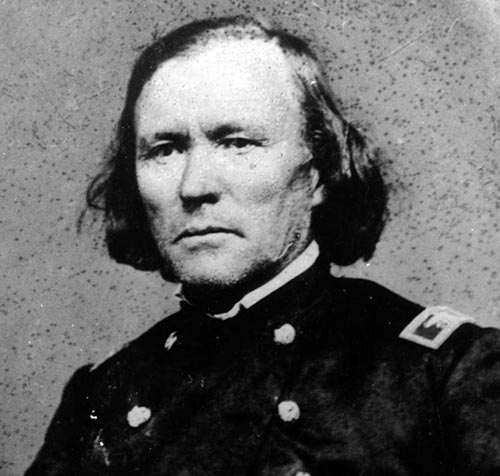
50 Years Ago: Basketball, Kit Carson made headlines in 1965

Kit Carson
While the tribal government continued to see Navajo Tribal Chairman Raymond Nakai and members of the Old Guard on the Navajo Tribal Council duke it out in the political arena, something special was being planned for April Fools Day on the Navajo reservation.
For the first time in their history, the Harlem Stars was putting on a show on a tribal reservation. The group was coming to spend April 1 in Window Rock.
Tribal officials said they expected a sold out crowd at the Field House in Fort Defiance. The Stars, a troupe similar to the much better known Harlem Globe Trotters, agreed to do a show in Fort Defiance since they were going to be doing a show in Albuquerque the day before.
The show promised to be “full of laughs and excitement,” according to officials of the Window Rock Booster Club, which was sponsoring the event.
The Stars would be playing the best basketball team on the reservation – the St Michaels Gold Medal Champs — at Day’s Drive Inn.
Tickets were $1.25 for adults and 50 cents for children and club members said the Stars had given them a big discount since the club hoped to make enough money from the event to purchase a neon sign at Judd Avery Field to honor the memory of the late Judd Avery.
On another subject, the Times reported this week in 1965 something that a lot of tribal members probably didn’t know – there were a lot of Navajos living in Los Angeles and surrounding communities.
In fact, there were more Navajos living in Los Angeles than were living in the three most populated communities on the reservation – Shiprock, Tuba City and Chinle -combined.
James A. Goss, who is with the Department of Anthropology, has recently published a newsletter that states about 100,000 Native Americans are making the Los Angeles area their home. Of these, some 10,000 are Navajos.
Goss said the purpose of his newsletter is to keep these 100,000 Natives informed about what is happening on their reservations as well as to let them know how well the other relocated members of their tribe are doing coping with life in Los Angeles.
Just as an aside, the Navajo Times would report in a few months that their biggest off-reservation subscriber city was not Los Angeles but Phoenix.
Remembering the old days was something that J. Lee Correll did almost everyday as a tribal employee.
Correll worked for the tribe on the Navajo-Hopi Land Dispute and was assigned the duty of helping the Navajos prove that Navajo ancestors occupied the lands that the Hopis were now claiming as belong to them in a lawsuit filed in the 1950s.
But he was also fascinated with Navajo history and was one of the few people – Navajo or non-Navajo – who were writing about Navajo history.
Fifty years ago, Correll made his first appearance in the Navajo Times writing about Kit Carson, who by the end of the century was scorned by most Navajos for his involvement in leading a campaign against the Navajos from 1863-1864 and helping the U.S. army destroy Navajo crops, burn down Navajo hogans and slaughter Navajo livestock.
But Correll’s story in the Navajo Times was not about this but one about Carson’s gentler side as the adoptive father of three Navajo children.
Correll had been able to find Catholic Church baptism records from 1860 to 1864, which showed that Carson and his wife, Josefa Jaramillo, “held three Navajos which they adopted according to the custom of the country.”
Correll’s research of the baptism records indicated to him that 2,000 or more Navajos at that time “were held as captives or purchased as slaves and servants by people living in the Rio Grande valley near Albuquerque.”
Correll said it was not uncommon for the non-Indian families to grow to like the Navajo children kept as slaves that they would eventually be adopted “by their masters and although their status remained inferior, they were often reared as members of the household in which they lived.”
If these figures were accurate and Correll said he had no reason to believe that they weren’t, this would mean back in the 1860s, a sizeable portion of Navajo children were being raised in non-Native households since the tribe’s population at that time was estimated to be somewhere in the area of 16,000.
Some of these children would eventually come back to the reservation when they got older but many would continue to live in the Anglo world.
And, according to the Times, something happened on March 27 that never happened before on the Navajo Reservation.
That was the day that Navajo voters in Indian Wells and White Cone elected Mrs. Roger Davis to be their representative on the Navajo Nation Council.
She wasn’t the first Navajo woman to be elected to the council but she was the first wife of a council delegate who died to be elected to replace him.
Interestingly, the Navajo Times referred to her only as Mrs. Roger Davis and never referred to her by her given name. But that was a common practice by the Times and other papers during their names – referring to the wives of tribal officials by their husband’s name.
To read the full article, pick up your copy of the Navajo Times at your nearest newsstand Thursday mornings!
Are you a digital subscriber? Read the most recent three weeks of stories by logging in to your online account.








 Highway 264,
Highway 264, I-40, WB @ Winslow
I-40, WB @ Winslow